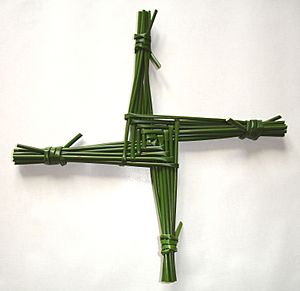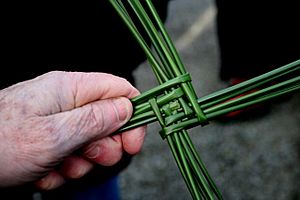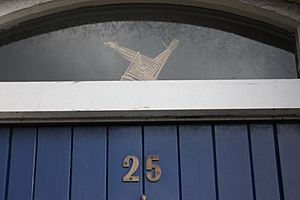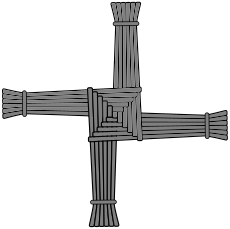Brigid's cross facts for kids
A Brigid's cross (also called Brigit's cross) is a special type of Christian cross from Ireland. It's usually woven from straw or rushes. These crosses come in many shapes. The most common ones have a woven diamond or lozenge shape in the middle.
The cross is named after Brigid of Kildare, a very important Irish saint. Legend says she wove a cross to help a non-Christian leader become a Christian before he died.
People usually weave Brigid's crosses on February 1st. This day is Saint Brigid's feast day. It's also the time of an old Irish festival called Imbolc. People believed that hanging a Brigid's cross in their homes brought good luck and protection from the saint all year. However, this tradition became less common in the 20th century. This was partly because modern houses made it harder to hang them.
Brigid's cross is a national symbol of Ireland, just like the shamrock and the Celtic harp. From 1962 to 1995, it was even part of the logo for Ireland's national TV and radio station, RTÉ. You can see a collection of these crosses at the National Museum of Ireland – Country Life. They were gathered by the Irish Folklore Commission.
Contents
What Does a Brigid's Cross Look Like?
Brigid's crosses are Christian crosses made from straw or rushes. Their exact shape can be very different. The National Museum of Ireland has found seven main types:
- Diamond crosses: These can have one or many diamond shapes.
- "Swastika" crosses: These have four or three arms.
- Wheel crosses: Shaped like a wheel.
- Interlaced crosses: Woven together.
- Traditional Latin crosses: Made from straw or rush.
- Bare wooden crosses: Latin or Greek style, tied with straw.
- A "miscellaneous" group for other designs.
The most popular type is the diamond or lozenge cross. It's common in parts of Ireland like Munster and Connacht. To make it, two sticks are crossed. Then, straw is woven into a diamond shape in the center. Sometimes, more woven diamonds are added to the four arms. Some people think the diamond shape in the middle is like a "god's eye" from Mexico or a "magic square" from Europe.
Another popular type is the "swastika" cross. Its arms are not straight like a normal cross. Instead, they are set at right angles from a diamond center. This makes it look like a wheel spinning. It might have once represented the sun. In some areas, a three-armed woven cross is used to show this spinning wheel idea. This three-armed cross is similar to the triskelion, a common Celtic design. Rarely, a Brigid's cross is placed completely inside a circle. This is called a "wheel cross" or "St. Brigid's Bow".
Unlike other Brigid's crosses, the interlaced cross is often made from rushes. It's just woven rush or straw strands in a cross shape. It doesn't have a woven shape in the middle. A simpler version is the bare cross. This is two bound straw plaits or two wooden planks tied with straw. Sometimes, no straw is used at all. In parts of County Galway and County Roscommon, they make a "Sheaf-Cross." This is two small bundles of unthreshed corn tied with a split thatching branch.
The Story Behind Brigid's Cross
Brigid's cross is named after Brigid of Kildare. She is the only female patron saint of Ireland. She was born around 450 CE in Leinster. We don't have many historical records about Brigid. Most of what we know comes from a book written about her life by a monk named Cogitosus. He wrote it about 200 years after she was born.
The most common story about Brigid's cross involves a non-Christian leader. In some stories, he was her father. While telling him about the Crucifixion of Jesus, Brigid picked up rushes from the ground. She wove them into a cross. After seeing this, the leader asked to be baptized as a Christian. Another story says Brigid was given a poisoned drink. She wove the cross to make the poison harmless.
Many stories about Saint Brigid are similar to those about an old pagan goddess named Brigid. It's likely that old legends and customs about the goddess were later connected to the saint. In pre-Christian Ireland, February 1st was the date of the Imbolc festival. This holiday was about farming and the start of spring. It's possible that the diamond and lozenge shapes were Celtic symbols for Imbolc. Then, Christian missionaries might have added arms to them to make them look like a cross. This gave the old symbols a new Christian meaning and linked them to Saint Brigid.
How People Use Brigid's Crosses
One tradition for Saint Brigid's feast day was to hang Brigid's crosses. People would put them in the rafters or above doorways of their homes and other buildings. This was to ask for the saint's blessing and protection for the year. Families would gather rushes on January 31st, the night before Brigid's feast day. After a special dinner, the head of the family would help everyone weave the crosses.
These crosses were left out overnight to receive Brigid's blessing. On February 1st, they were hung in homes, outhouses, and stables. The center of the cross is often a lozenge, not a square. This suggests that the cross should be hung in a saltire style (like an 'X'), not like a traditional Latin cross. Crosses were either replaced every year or allowed to build up. If old crosses were removed, they were burned or buried. Burying them was preferred because Brigid is linked to farming.
Weaving Brigid's crosses was popular across Ireland, especially in the north and middle. But its popularity went down in the 20th century. Some families felt this was because house renovations made it hard to hang the crosses. Outside of Ireland, Brigid's crosses are also hung in Glastonbury, England. A local legend says Brigid of Kildare visited the town in 488 CE. Families might also send woven crosses to friends and relatives living abroad. People sometimes carry a cross with them when they leave Ireland.
Weaving crosses wasn't just for Brigid's feast day. Friends would often give crosses as gifts to bring blessings and strengthen their friendship. Newly married couples sometimes received "womb crosses" to hang above their door. This was because Brigid was also a patron of fertility.
The weaving of Brigid's cross is similar to other rituals. These rituals involve weaving the last bundle of that year's harvest into special shapes. For example, in County Armagh, people weave "Harvest Knots" and "Harvest Stars." The Harvest Knot has a lozenge shape like Brigid's cross. These "last sheaf" celebrations are known as the Cailleach.
Brigid's Cross as a National Symbol
After the Irish Free State became independent in 1922, Brigid's cross became an important national symbol. It joined other Irish symbols like the shamrock and the Celtic harp. Artists used these symbols to create a unique Irish culture, separate from Britain. In the 1950s, Brigid's cross was added to the logo of the Irish Department of Health. As of 2009, the cross was still part of the logo for the Nursing and Midwifery Board of Ireland. They often use Brigid in their images because she is linked to midwifery.
In 1962, Brigid's cross was chosen as the first symbol for Raidió Teilifís Éireann (RTÉ), Ireland's national broadcaster. Alice Curtayne wrote that the cross was chosen to bring to mind "quiet, serene places in the springtime of our history." The RTÉ logo changed nine times between 1962 and 1987. The cross had different levels of importance compared to the station's name. In 1995, it was removed from the RTÉ logo. The station wanted a "clean striking piece of modern design." Carol Coulter from The Irish Times felt that this meant "Saint Brigid's cross has lost its place as a symbol of our national identity."
In 1942, the Irish Folklore Commission created a survey about the Feast of Saint Brigid. During this time, they collected hundreds of Brigid's crosses. In 2022, the Commission chose 21 of these crosses to show at the National Museum of Ireland – Country Life in Castlebar. This display happened at the same time the Irish government announced that February 1st would become a national holiday.
See also
 In Spanish: Cruz de Santa Brigida para niños
In Spanish: Cruz de Santa Brigida para niños





